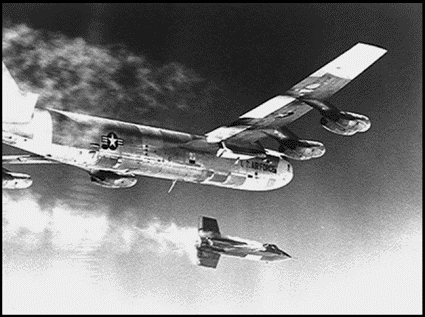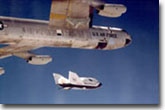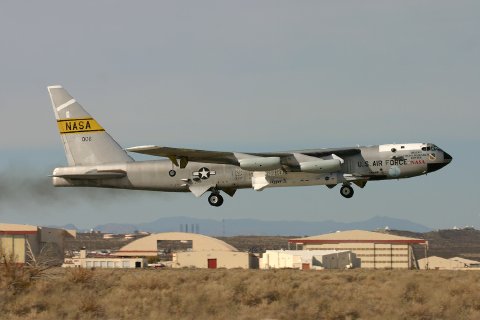


 |
 |
 |

NASA B-52, Tail Number 008, was an air launch carrier aircraft, 'mothership,' as well as a research aircraft platform that has been used on a variety of research projects. Affectingly known as 'Balls-8,' the 10th B-52 produced, was first flown on June 11, 1955, was the oldest B-52 in flying status and has been used on some of the most significant research projects in  aerospace history.
aerospace history.
The bomber arrived at Edwards AFB on June 8, 1959, after undergoing modifications at North American Aviation's Palmdale facility to allow it to carry the X-15 beneath its right wing. The modified bomber first was used to launch the X-15 on its fifth flight, Jan. 23, 1960.
Some of the significant projects supported by B-52 008 include the X-15, the lifting bodies, HiMAT (highly maneuverable aircraft technology), Pegasus, validation of parachute systems developed for the space shuttle program (solid-rocket-booster recovery system and the orbiter drag chute system), and the X-38. Among the many milestone flights Balls Eight launched were William J. 'Pete' Knight's record-setting Mach 6.7 flight in the X-15, the X-15 flights that qualified four pilots for astronaut wings and the first successful test flights of a supersonic combustion ramjet - or scramjet - engine on its final program.
The B-52 served as the launch vehicle on 106 X-15 flights and flew a total of 159 captive-carry and launch missions in support of that program from June 1959 to October 1968. Her starboard side is plastered with mission markings for HiMat, Pegasus, X-38, X- this, X-that...! She may well be the single most famous airframe since the 'Spirit of St. Louis' and the 'Enola Gay'. After nearly two decades with the Air Force, she was transferred to NASA where she has served faithfully. Though she still has the lowest airframe hours of any B-52 in service, parts for the old B model are hard to come by.
Information gained from the highly successful X-15 program contributed to the Mercury, Gemini, and Apollo human spaceflight programs as well as space shuttle development. Between 1966 and 1975, the B-52 served as the launch aircraft for 127 of the 144 wingless lifting body flights. In the 1970s and 1980s, the B-52 was the launch aircraft for several aircraft at what is now the Dryden Flight Research Center, Edwards, California, to study spin-stall, high-angle-of attack, and maneuvering characteristics. These included the 3/8-scale F-15/spin research vehicle (SRV), the HiMAT (Highly Maneuverable Aircraft Technology) research vehicle, and the DAST (drones for aerodynamic and structural testing). The aircraft supported the development of parachute recovery systems used to recover the space shuttle solid rocket booster casings. It also supported eight orbiter (space shuttle) drag chute tests in 1990. In addition, the B-52 served as the air launch platform for the first six Pegasus space boosters.
During its many years of service, the B-52 has undergone several modifications. The first  major modification was made by North American Aviation (now part of Boeing) in support of the X-15 program. This involved creating a launch-panel-operator station for monitoring the status of the test vehicle being carried, cutting a large notch in the right inboard wing flap to accommodate the vertical tail of the X-15 aircraft, and installing a wing pylon that enables the B-52 to carry research vehicles and test articles to be air-launched/dropped. Located on the right wing, between the inboard engine pylon and the fuselage, this wing pylon was subjected to extensive testing prior to its use. For each test vehicle the B-52 carried, minor changes were made to the launch-panel operator's station.
major modification was made by North American Aviation (now part of Boeing) in support of the X-15 program. This involved creating a launch-panel-operator station for monitoring the status of the test vehicle being carried, cutting a large notch in the right inboard wing flap to accommodate the vertical tail of the X-15 aircraft, and installing a wing pylon that enables the B-52 to carry research vehicles and test articles to be air-launched/dropped. Located on the right wing, between the inboard engine pylon and the fuselage, this wing pylon was subjected to extensive testing prior to its use. For each test vehicle the B-52 carried, minor changes were made to the launch-panel operator's station.
Built originally by the Boeing Company, the NASA B-52 is powered by eight Pratt & Whitney J57-19 turbojet engines, each of which produce 12,000 pounds of thrust. The aircraft's normal launch speed has been Mach 0.8 (about 530 miles per hour) and its normal drop altitude has been 40,000 to 45,000 feet. It is 156 feet long and has a wing span of 185 feet. The heaviest load it has carried was the No. 2 X-15 aircraft at 53,100 pounds.
Another B-52 (an A-model), Tail Number 003, also flew as a mothership, launching the X-15 and lifting bodies.
For the launch platform, NASA 0008, the B-52B testbed that has been a fixture at Edwards since the 1950s. Fritz Fullerton piloted the bomber on its final research mission, the successful Nov. 16 flight of the unmanned X-43A hypersonic scramjet research vehicle. That flight set a speed record for air-breathing aircraft, reaching speeds of nearly Mach 10. After 45 years of service and over 400 missions, Balls-8 was retired from active duty in December 2004 with the distinction of being the oldest mothership in the NASA fleet and the oldest B-model B-52 left flying.
For 45 years the hulking B-52 mothership - fondly known as 'Balls Eight' for its tail number of 008 - was the stalwart platform for numerous research missions, beginning with the famed X-15 rocket plane launched at 540 mph at 45,000 feet. The history of the mothership, is inscribed along the right side of the fuselage in the form of 'hieroglyphics,' silhouettes of the vehicles and test fixtures flown. The lengthy history stretches from the X-15 and lifting body flights grouped together just behind the nose all the way down the fuselage to the X-43A flight that marked the end of the B-52's career. During its retirement ceremony, Air Force Flight Test Center Commander Gen. Curtis Bedke noted that 'her legacy does live on in the skies over Edwards Air Force Base.' Former pilot Fitz Fulton, believed to have more hours logged in the bomber than any other pilot, described flying 008 as 'a fun job.'
An Air Force asset, the bomber was maintained and operated by Air Force personnel throughout the X-15 program, a joint effort among the service, NASA, the Navy and North American Aviation. Although primarily used by NASA, the bomber remained in Air Force control until April 1976, when it was placed on permanent loan to the agency.
Though the oldest B-52 flying, 008 had the least number of flight hours - 2,443.8 hours over almost 50 years - due to its exclusive use in flight testing. The cockpit of the bomber appears at first glance to have avoided the digital age altogether, with row upon row of analog gauges and dials. Pilots did have one vital piece of digital technology, however. Attached to the edge of the control panel was a small digital kitchen timer, its white plastic case yellowed from the sunlight streaming through the cockpit windows. The timer was used to mark time for missions. Being the only B-model bomber left in operation, maintenance crews had to be resourceful to keep 008 flying. They scavenged parts from bone yards and even museums and sometimes cobbled together multiple pieces to make one good part. Nonetheless, no mission was ever cancelled because of 008.
The bomber also was the only airplane left that used JP-4, an old formula of jet fuel. "That's a little like seeking leaded fuel for an old car, 23,000 gallons at a time," said Kevin Petersen, NASA Dryden Flight Research Center director. Balls-8 has been retired to the North Gate entrance of Edwards AFB.



Final mission flown by Balls-8
 |
 |
 |